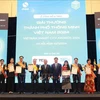HCM City (VNA) – Using information technology in agriculture is imperative for improving productivity and quality and reducing costs to bolster the sector’s competitiveness amid the country’s integration, a seminar heard in HCM City on July 5.
Tu Minh Thien, Deputy Head of the Agricultural High Tech Park of HCM City (AHTP), told the seminar organised by AHTP, Quang Trung Software City, and Global CyberSoft Vietnam (GCS) that technology in the sector is developing slower than in other sectors, while the country’s research and development capabilities lag behind others.
With tariff exemption under the Trans Pacific Partnership agreement, the agricultural sector would enjoy opportunities to boost exports, Thien said.
But it continues to face shortcomings in terms of strains, production, harvest, post-harvest, and transportation, he said.
Therefore, it needs to develop a hi-tech production chain based on international standards and support farmers access businesses’ supply chain, he said.
The main tasks are to build and operate a sustainable goods supply chain for both the export and domestic markets, develop links between farmers, cooperatives and other production groups to expand supply between them and distributors to ensure outlets for their produce, he said.
AHTP in collaboration with the Quang Trung Software City and Global CyberSoft Vietnam have piloted the SmartAgri project on cantaloupe at the park since last December.
The project has seen early positive results, with cantaloupe output going up by 10 percent and their quality and weight remaining consistent, he said.
Tran Kim Vu of Global CyberSoft Vietnam said SmartAgri is an agriculture production management system from the nursery to harvest and preservation.
It is developed based on the most advanced technologies, including the Internet of Things big data analytics and cloud computing.
Traditionally, checking humidity, temperature, and light intensity for plants has been done manually and mainly based on experience, he said.
SmartAgri helps collect and analyse the information about temperature, moisture, light, and pH automatically through sensors.
This ensures standard environmental conditions for the plants.
Its other features include a real-time alert system via SMS, email and alarm and analysis of quantity and quality, he said.
It helps establish an agricultural ecosystem for exchanging information, sharing experience and planning production among farmers, retailers, traders, and enterprises, he said.
It automates crop, livestock and fishery production processes.
The application of this system would help boost both quality and quantity of agricultural produce, decrease costs and improve competitiveness.
It would enable production to conform to VietGap and Global Gap standards to enable more exports to difficult markets like the US, Japan, and EU.
But the model has only been tested in plastic greenhouse cultivation models, and experts would continue research to come up with new applications appropriate for farmers’ needs, he added.-VNA























